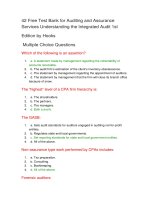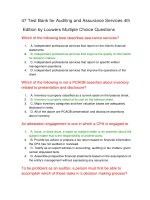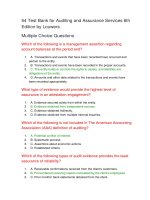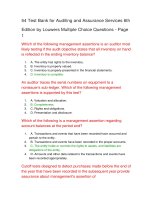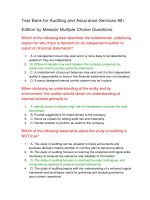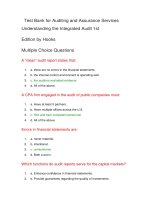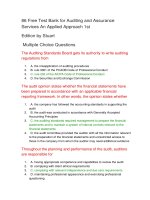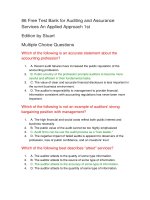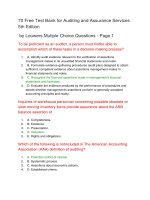Test bank for auditing and assurance services 6th
Bạn đang xem bản rút gọn của tài liệu. Xem và tải ngay bản đầy đủ của tài liệu tại đây (98.43 KB, 20 trang )
Test Bank for Auditing and Assurance Services 6th
Free Text Questions
What are the four basic requirements for becoming a CPA?
Answer Given
Education, the CPA Examination, experience, and a state certificate.
What is information risk? What is business risk?
Answer Given
Information risk is the risk that financial statements will be materially false or
misleading. Business risk is the risk an entity will fail to meet its objectives.
Define assurance, attestation, and auditing in the context of "lending
credibility."
Answer Given
Assurance is the "lending of credibility" to information. Attestation is the "lending of
credibility" to assertions made by a third party. Auditing is the "lending of credibility" to
financial statements.
What are the differences between the American Accounting Association and
AICPA definitions and objectives of auditing?
Answer Given
The AAA definition is broad and general enough to encompass independent, internal,
and governmental auditing. The AICPA has not defined auditing but its statement on
objectives of financial audits restricts auditing to independent CPA's audit of the
traditional financial statements and their footnotes. The AICPA SAS also offers guides
to report on internal control, letters to underwriters, and special reports.
What is operational auditing and by whom is it performed?
Answer Given
Operational auditing is the evaluation of business operations for various purposes.
Operational auditing includes: (1) testing for compliance with laws and regulations and
company policies and procedures, (2) evaluating the effectiveness of operations in
achieving goals and objectives, and (3) evaluating the efficiency and economy of
operations. Operational audits are normally performed by internal auditors. However,
operational audits also may be conducted by independent CPA firms as part of their
management advisory services.
Multiple Choice Questions - Page 1
Cutoff tests designed to detect purchases made before the end of the year
that have been recorded in the subsequent year provide assurance about
management's assertion of
1.
A. presentation and Disclosure.
2.
B. completeness.
3.
C. rights and obligations.
4.
D. existence.
An auditor selected items from the client's detailed inventory listing (that
agreed to the financial statements). During the physical inventory
observation, the auditor then found each item selected and counted the
number of units on hand. Assuming that the amount on hand was the same as
the amount in the client's detailed inventory listing, this procedure most likely
would provide evidence concerning management's assertion of
1.
A. completeness.
2.
B. valuation.
3.
C. presentation and disclosure.
4.
D. existence.
5.
E. rights and obligations.
A practitioner is engaged to express an opinion on management's assertion
that the square footage of a warehouse offered for sale is 150,000 square feet.
The practitioner should refer to which of the following sources for
professional guidance?
1.
A. Statement of Auditing Standards.
2.
B. Statements on Standards for Attestation Engagements.
3.
C. Statements on Standards for Accounting and Review Services.
4.
D. Statements on Standards for Consulting Services.
If an auditor is performing procedures related to the information that is
contained in the client's pension footnote, he/she is most likely obtain
evidence concerning management's assertion about
1.
A. rights and obligations.
2.
B. existence.
3.
C. valuation.
4.
D. presentation and disclosure.
An auditor traces the serial numbers on equipment to a nonissuer's subledger. Which of the following management assertions is supported by this
test?
1.
A. Valuation and allocation.
2.
B. Completeness.
3.
C. Rights and obligations.
4.
D. Presentation and disclosure.
Which of the following types of audit evidence provides the least assurance of
reliability?
1.
A. Receivable confirmations received from the client's customers.
2.
B. Prenumbered receiving reports completed by the client's employees.
3.
C. Prior months' bank statements obtained from the client.
4.
D. Municipal property tax bills prepared in the client's name.
During an audit of an entity's stockholders' equity accounts, the auditor
determines whether there are restrictions on retained earnings resulting from
loans, agreements or state law. This audit procedure most likely is intended to
verify management's assertion of
1.
A. existence or occurrence.
2.
B. completeness.
3.
C. valuation or allocation.
4.
D. presentation and disclosure.
An auditor selected items for test counts from the client's warehouse during
the physical inventory observation. The auditor then traced these test counts
into the detailed inventory listing that ultimately agreed to the financial
statements. This procedure most likely provided evidence concerning
management's assertion of
1.
A. completeness.
2.
B. valuation.
3.
C. presentation and disclosure.
4.
D. existence.
To be proficient as an auditor, a person must first be able to accomplish
which of these tasks in a decision-making process?
1.
A. Identify audit evidence relevant to the verification of assertions management makes
in its unaudited financial statements and notes.
2.
B. Formulate evidence-gathering procedures (audit plan) designed to obtain sufficient,
competent evidence about assertions management makes in financial statements and
notes.
3.
C. Recognize the financial assertions made in management's financial statements and
footnotes.
4.
D. Evaluate the evidence produced by the performance of procedures and decide
whether management's assertions conform to generally accepted accounting principles
and reality.
Which of the following is a management assertion regarding account
balances at the period end?
1.
A. Transactions and events that have been recorded have occurred and pertain to the
entity.
2.
B. Transactions and events have been recorded in the proper accounts.
3.
C. The entity holds or controls the rights to assets, and liabilities are obligations of the
entity.
4.
D. Amounts and other data related to the transactions and events have been recorded
appropriately.
What type of evidence would provide the highest level of assurance in an
attestation engagement?
1.
A. Evidence secured solely from within the entity.
2.
B. Evidence obtained from independent sources.
3.
C. Evidence obtained indirectly.
4.
D. Evidence obtained from multiple internal inquiries.
The audit objective that all transactions and accounts that should be
presented in the financial statements are in fact included is related to which of
the PCAOB assertions?
1.
A. Existence
2.
B. Rights and obligations
3.
C. Completeness
4.
D. Valuation
Which of the following management assertions is an auditor most likely
testing if the audit objective states that all inventory on hand is reflected in
the ending inventory balance?
1.
A. The entity has rights to the inventory.
2.
B. Inventory is properly valued.
3.
C. Inventory is properly presented in the financial statements.
4.
D. Inventory is complete.
What is the term used to identify the risk that the client's financial statements
may be materially false and misleading?
1.
A. Business risk
2.
B. Information risk
3.
C. Client risk
4.
D. Risk assessment
An auditor has substantial doubt about the entity's ability to continue as a
going concern for a reasonable period of time because of negative cash flows
and working capital deficiencies. Under these circumstances, the auditor
would be most concerned about the
1.
A. control environment factors that affect the organizational structure.
2.
B. correlation of detection risk and inherent risk.
3.
C. effectiveness of the entity's internal control activities.
4.
D. possible effects on the entity's financial statements.
Which of the following is not a recommendation usually made following the
completion of an operational audit?
1.
A. Economic and efficient use of resources
2.
B. Effective achievement of business objectives
3.
C. Attesting to the fairness of the financial statements
4.
D. Compliance with company policies
In auditing the long term debt account, an auditor's procedures most likely
would focus primarily on management's assertion of
1.
A. existence.
2.
B. completeness.
3.
C. allocation.
4.
D. rights and obligations.
The confirmation of an account payable balance selected from the general
ledger provides primary evidence regarding which management assertion?
1.
A. Completeness
2.
B. Valuation
3.
C. Allocation
4.
D. Existence
Which of the following is an underlying condition that in part creates the
demand by users for reliable information?
1.
A. Economic transactions that are numerous and complex
2.
B. Decisions are time-sensitive
3.
C. Users separated from accounting records by distance and time
4.
D. Financial decisions that are important to investors and users
5.
E. All of these
According to PCAOB Auditing Standard No. 5 (AS 5), the auditor should
identify significant accounts and disclosures and their relevant assertions.
Which of the following financial statement assertions is not explicitly
identified in AS 5?
1.
A. Completeness
2.
B. Valuation or Allocation
3.
C. Accuracy
4.
D. Existence or Occurrence
5.
E. All of these are assertions identified in AS 5.
When testing the completeness assertion for a liability account, an auditor
ordinarily works from the
1.
A. financial statements to the potentially unrecorded items.
2.
B. potentially unrecorded items to the financial statements.
3.
C. accounting records to the supporting evidence.
4.
D. trial balance to the subsidiary ledger.
Which of the following questions would be inappropriate for an auditor to ask
a client when exhibiting an appropriate level of professional skepticism while
completing an audit procedure related to the internal control system?
1.
A. What can go wrong in this process?
2.
B. Which of your employees is a fraudster?
3.
C. What else is important to know about this process?
4.
D. What happens when a key employees goes on vacation?
Which of the following is not included in The American Accounting
Association (AAA) definition of auditing?
1.
A. Potential conflict of interest
2.
B. Systematic process
3.
C. Assertions about economic actions
4.
D. Established criteria
54 Free Test Bank for Auditing and Assurance Services
6th Edition by Louwers Multiple Choice Questions - Page
2
Inquiries of warehouse personnel concerning possible obsolete or slow
moving inventory items provide assurance about the ASB balance assertion
of
1.
A. completeness.
2.
B. existence.
3.
C. presentation.
4.
D. valuation.
5.
E. rights and obligations.
In performing an attestation engagement, a CPA typically
1.
A. supplies litigation support services.
2.
B. assesses control risk at a low level.
3.
C. expresses a conclusion on an assertion about some type of subject matter.
4.
D. provides management consulting advice.
Which of the following is not an ASB assertion about inventory related to
presentation and disclosure?
1.
A. Inventory is properly classified as a current asset on the balance sheet.
2.
B. Inventory is properly stated at cost on the balance sheet.
3.
C. Major inventory categories and their valuation bases are adequately disclosed in
notes.
4.
D. All of these are ASB presentation and disclosure assertions about inventory.
The audit objective that all transactions are recorded in the proper period is
related most closely to which of the Audit Standards Board (ASB) transaction
assertions?
1.
A. Occurrence
2.
B. Completeness
3.
C. Cutoff
4.
D. Accuracy
The audit objective that all balances include all items that should be recorded
in that account is related most closely to which one of the ASB balance
assertions?
1.
A. Existence
2.
B. Rights and obligations
3.
C. Completeness
4.
D. Valuation
Because of the risk of material misstatement, an audit of financial statements
in accordance with generally accepted auditing standards should be planned
and performed with an attitude of
1.
A. objective judgment.
2.
B. independent integrity.
3.
C. professional skepticism.
4.
D. impartial conservatism.
The auditor's judgment concerning the overall fairness of the presentation of
financial position, results of operations, and cash flows is applied within the
framework of
1.
A. quality control.
2.
B. generally accepted auditing standards, which include the concept of materiality.
3.
C. the auditor's evaluation of the audited company's internal control.
4.
D. the applicable financial reporting framework (i.e., GAAP in the United States).
Inquiries of warehouse personnel concerning possible obsolete or slow
moving inventory items provide assurance about the PCAOB assertion of
1.
A. completeness.
2.
B. existence.
3.
C. presentation.
4.
D. valuation.
5.
E. rights and obligations.
The probability that the information circulated by a company will be false or
misleading is referred to as
1.
A. business risk.
2.
B. information risk.
3.
C. assurance risk.
4.
D. audit risk.
The Sarbanes-Oxley Act of 2002 requires that the key company officials certify
the financial statements. Certification means that the company CEO and CFO
must sign a statement indicating
1.
A. they have read the financial statements.
2.
B. they are not aware of any false or misleading statements (or any key omitted
disclosures).
3.
C. they believe that the financial statements present an accurate picture of the
company's financial condition.
4.
D. All of these.
In order to be considered as external auditors with respect to government
agencies, GAO auditors must be
1.
A. organizationally independent.
2.
B. empowered as the accounting and auditing agency by the U.S. Congress.
3.
C. funded by the federal government.
4.
D. guided by standards similar to GAAS.
The four basic requirements for becoming a CPA in most states are
1.
A. education, the CPA Examination, experience, and substantial equivalency.
2.
B. the CPA Examination, experience, continuing professional education, and a state
certificate.
3.
C. continuing professional education, the CPA Examination, experience, and an AICPA
certificate.
4.
D. education, the CPA Examination, experience, and a state certificate.
The audit objective that all the transactions and accounts presented in the
financial statements represent real assets, liabilities, revenues, and expenses
is related most closely to which of the PCAOB assertions?
1.
A. Existence or occurrence
2.
B. Rights and obligations
3.
C. Completeness
4.
D. Presentation and disclosure
The audit objective that all balances include items owned by the client is
related most closely to which one of the ASB balance assertions?
1.
A. Existence
2.
B. Rights and obligations
3.
C. Completeness
4.
D. Valuation
Which of the following best describes the primary role and responsibility of
independent external auditor?
1.
A. Produce a company's annual financial statements and notes.
2.
B. Express an opinion on the fairness of a company's annual financial statements and
footnotes.
3.
C. Provide business consulting advice to audit clients.
4.
D. Obtain an understanding of the client's internal control structure and give
management a report about control problems and deficiencies.
The underlying conditions that create demand by users for reliable
information include all of the following, except
1.
A. transactions are numerous and complex.
2.
B. users lack professional skepticism.
3.
C. users are separated from accounting records by distance and time.
4.
D. financial decisions are important to investors and users.
5.
E. decisions are time-sensitive.
The audit objective that all transactions are recorded in the proper account is
related most closely to which one of the ASB transaction assertions?
1.
A. Occurrence
2.
B. Completeness
3.
C. Accuracy
4.
D. Classification
The process of a CPA obtaining a certificate and license in a state other than
the state in which the CPA's certificate was originally obtained is referred to
as
1.
A. substantial equivalency.
2.
B. quid pro quo.
3.
C. relicensing.
4.
D. re-examination.
The study of business operations for the purpose of making
recommendations about the efficient use of resources, effective achievement
of business objectives, and compliance with company policies is referred to
as
1.
A. environmental auditing.
2.
B. financial auditing.
3.
C. compliance auditing.
4.
D. operational auditing.
Which of the following best describes assurance services?
1.
A. Independent professional services that report on the client's financial statements
2.
B. Independent professional services that improve the quality of information for
decision makers
3.
C. Independent professional services that report on specific written management
assertions
4.
D. Independent professional services that improve the operations of the client
The engineering department at Omni Company built a piece of equipment in
the company's own shop for use in the company's operations. The auditor
reviewed all work orders that were capitalized as part of the equipment costs.
Which of the following is the ASB transaction assertion most closely related
to the auditor's testing?
1.
A. Occurrence
2.
B. Completeness
3.
C. Accuracy
4.
D. Classification
Which of the following best describes the main reason independent auditors
report on management's financial statements?
1.
A. Management fraud may exist and it is likely to be detected by independent auditors.
2.
B. The management that prepares the statements and the persons who use the
statements may have conflicting interests.
3.
C. Misstated account balances may be corrected as the result of the independent audit
work.
4.
D. The management that prepares the statements may have a poorly designed system
of internal control.
Assurance services involve all of the following, except
1.
A. relevance as well as the reliability of information.
2.
B. nonfinancial information as well as traditional financial statements.
3.
C. providing absolute rather than reasonable assurance.
4.
D. electronic databases as well as printed reports.
Cutoff tests designed to detect credit sales made before the end of the year
that have been recorded in the subsequent year provide assurance about the
PCAOB assertion of
1.
A. presentation.
2.
B. completeness.
3.
C. rights.
4.
D. existence.
Which of the following is not a PCAOB assertion about inventory related to
presentation and disclosure?
1.
A. Inventory is properly classified as a current asset on the balance sheet.
2.
B. Inventory is properly stated at its cost on the balance sheet.
3.
C. Major inventory categories and their valuation bases are adequately disclosed in
notes.
4.
D. All of these are PCAOB presentation and disclosure assertions about inventory
The audit objective that footnotes in the financial statements should be clear
and expressed such that the information is easily conveyed to the readers of
the financial statements is related most closely with which of the ASB
presentation and disclosure assertions?
1.
A. Occurrence
2.
B. Rights and obligations
3.
C. Comprehensibility
4.
D. Understandability
Which of the following is the essential purpose of the audit function?
1.
A. Detection of fraud
2.
B. Examination of individual transactions to certify as to their validity
3.
C. Determination of whether the client's financial statement assertions are fairly state
4.
D. Assurance of the consistent application of correct accounting procedures
The engineering department at Omni Company built a piece of equipment in
the company's own shop for use in the company's operations. When looking
at the ending balance for the fixed asset account the auditor examined all
work orders, purchased materials, labor cost reports, and applied overhead
that were capitalized as part of the equipment costs. Which of the following is
the ASB balance assertion most closely related to the auditor's testing?
1.
A. Existence
2.
B. Completeness
3.
C. Rights and obligations
4.
D. Valuation
An attestation engagement is one in which a CPA is engaged to
1.
A. issue, or does issue, a report on subject matter or an assertion about the subject
matter that is the responsibility of another party.
2.
B. provide tax advice or prepare a tax return based on financial information the CPA
has not audited or reviewed.
3.
C. testify as an expert witness in accounting, auditing or tax matters, given certain
stipulated facts.
4.
D. assemble prospective financial statements based on the assumptions of the entity's
management without expressing any assurance.
The accounting, auditing, and investigating agency of the U.S. Congress,
headed by the U.S. Comptroller General is known as
1.
A. the Federal Bureau of Investigation (FBI).
2.
B. the U.S. General Accountability Office (GAO).
3.
C. the Internal Revenue Service (IRS).
4.
D. the United States Legislative Auditors (USLA).
The risk an entity will fail to meet its objectives is referred to as
1.
A. business risk.
2.
B. information risk.
3.
C. assurance risk.
4.
D. audit risk.
